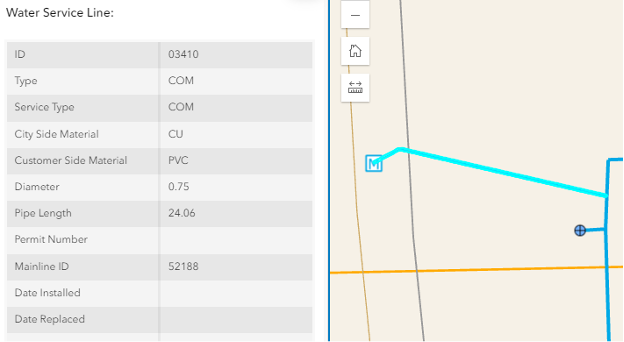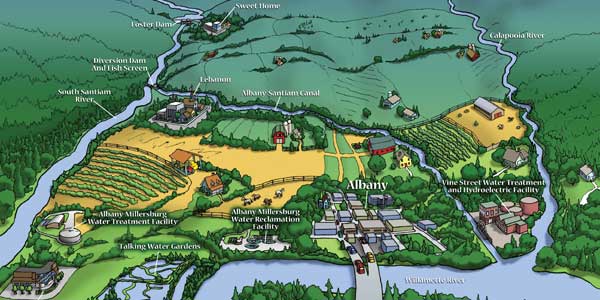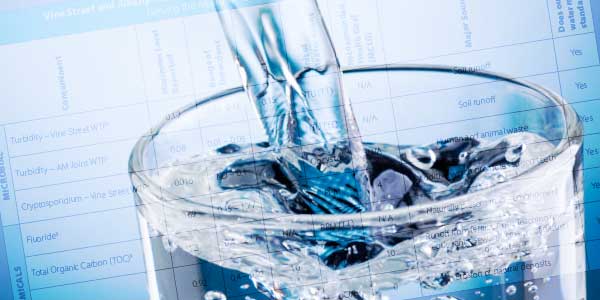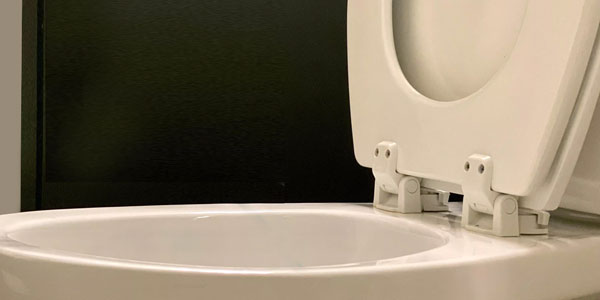2024 Water Quality Report
To our valued customers,
The Albany Public Works Department is pleased to present the 2024 Annual Water Quality Report for Albany and Millersburg. This report provides important information about the high quality of the drinking water Albany provides to homes, businesses, and industry 24 hours a day throughout the year. This information is provided to you in compliance with U.S. Environmental Protection Agency requirements.
Albany regularly monitors the quality of our water to ensure we are producing and delivering excellent drinking water. In 2024, Albany met or exceeded all state and federal standards for safe drinking water. We place great importance on delivering excellent water and work hard to meet our goal of providing high-quality and dependable service for all of our customers.
If you have any questions about this report or the City’s drinking water system in general, please contact the City of Albany at 541-917-7600 or albanyoregon.gov/contact-the-city. To contact the City of Millersburg, call 541-928-4523. To provide input on our water quality, Albany invites you to join us at City Council meetings, which are typically held on the second and fourth Wednesdays of each month at 6:00 p.m. in City Hall, 333 Broadalbin Street SW.

Chris Bailey
Public Works Director
- Details
Reducing Exposure to Lead
Lead-contaminated drinking water in Flint, Michigan, Portland, and Tacoma has drawn national attention to the issue of controlling lead exposure in public drinking water systems. The City of Albany has worked to control lead in its water system for many years; it is one of our standard operating procedures for keeping drinking water clean and safe.
Lead in drinking water is primarily from materials and components associated with service lines and home plumbing. If present, elevated levels of lead in drinking water can cause serious health problems, especially for pregnant women and young children. In 1991, the Environmental Protection Agency (EPA) published a regulation to control lead and copper in drinking water. The lead and copper rule requires the City to collect water samples at customer taps to be analyzed for lead and copper, which can be present in drinking water if materials in a water system’s distribution pipes or a building’s plumbing contain either metal. Certain characteristics of drinking water (primarily the pH) can cause fixtures with lead-based solder and brass faucets to corrode. When water is in contact with these fixtures over time, lead or copper can be released into the water. The amount of lead and/or copper can increase when water is in contact with such fixtures for extended periods. If lead or copper concentrations exceed the action level in more than 10% of customer samples, the City must take additional steps to control corrosion.
Service Line Inventory and Ongoing Lead and Copper Testing
Under guidance from Oregon Health Authority and Environmental Protection Agency, the City of Albany and Millersburg staff inspected all service lines that were installed prior to 1986 to determine the material. Using city and county records, City staff inspected over 9,000 drinking water service and found no lead lines in our systems. Service lines installed after 1986 are considered to be non-lead due to changes in the Oregon Uniform Plumbing Code.
Service line material can be viewed on InfoHub by clicking on the service line in question.

The City of Albany Public Works Department is responsible for providing high-quality drinking water but cannot control the variety of materials used in private plumbing components. When water has been sitting for several hours, the potential for lead exposure can be minimized by flushing the tap for 30 seconds to two minutes before using water for drinking or cooking. If you are concerned about lead in your water, you may wish to have your water tested. Information on lead in drinking water, testing methods, and steps you can take to minimize exposure is available from the Safe Drinking Water Hotline at 800-426-4791 or at www.epa.gov/safewater/lead.
The cities of Albany and Millersburg and the Dumbeck Lane Water District are in compliance with the lead and copper rule. The most recent water quality results can be viewed on this page. All results for any public water system can be viewed by visiting the Oregon Health Authority Drinking Water Services Water Online at https://yourwater.oregon.gov/. If you have questions or believe the plumbing in your home dates from 1983-1985 and would like to be in our sampling plan, please contact the Water Operations Supervisor at 541-917-7628.
What Albany is doing to reduce lead in drinking water
- Details
What the EPA Wants You to Know about Contaminants in Source Waters
Drinking water, including bottled water, may reasonably be expected to contain at least small amounts of some contaminants. The presence of contaminants does not necessarily indicate that water poses a health risk. More information about contaminants and potential health effects can be obtained by calling the Environmental Protection Agency’s Safe Drinking Water Hotline at 800-426-4791 or at epa.gov/safewater.
The sources of drinking water (both tap water and bottled water) include rivers, lakes, streams, ponds, reservoirs, springs and wells. As water travels over the surface of the land or through the ground, it dissolves naturally-occurring minerals and, in some cases, radioactive material, and can pick up substances resulting from the presence of animals or from human activity.
Contaminants in drinking water sources may include:
- Microbial contaminants
- such as viruses and bacteria, which may come from sewage treatment plants, septic systems, agricultural livestock operations, and wildlife;
- Inorganic contaminants
- such as salts and metals, which can be naturally-occurring or result from urban stormwater runoff, industrial or domestic wastewater discharges, oil and gas production, mining, or farming;
- Pesticides and herbicides
- which may come from a variety of sources such as agriculture, urban stormwater runoff, and residential uses;
- Organic chemical contaminants
- including synthetic and volatile organic chemicals, which are byproducts of industrial processes and petroleum production, and which can also come from gas stations, urban stormwater runoff, and septic systems;
- Radioactive contaminants
- which can be naturally-occurring or be the result of oil and gas production and mining activities.
In order to ensure that tap water is safe to drink, EPA prescribes regulations that limit the amount of certain contaminants in water provided by public water systems. Food and Drug Administration regulations establish limits for contaminants in bottled water that must provide the same protection for public health.
Special Notice for Immuno-compromised Persons
Some people may be more vulnerable to contaminants in drinking water than the general population. Immuno-compromised persons such as those with cancer undergoing chemotherapy or who have undergone organ transplants, people with HIV/AIDS or other immune system disorders, some elderly, and infants can be particularly at risk from infections. These people should seek advice about drinking water from their health care providers. Guidelines from the Environmental Protection Agency and Centers for Disease Control and Prevention on appropriate means to lessen the risk of infection by cryptosporidium and other microbial contaminants are available from the Safe Drinking Water Hotline at 800-426-4791.
- Details
Where do we get our drinking water?
The cities of Albany and Millersburg receive their drinking water from the Santiam River system through one of two water treatment plants.
- Details
Regulated Contaminants
The City of Albany sampled for 90 regulated contaminants on a continuous, daily, monthly, quarterly, annual, or reduced monitoring program in 2024. The federal Environmental Protection Agency requires disclosure of any regulated contaminants that were detected in the Albany-Millersburg public water system. Where allowed to monitor less often than once a year, the City of Albany is required to report contaminants detected within the last five years.
- Details







